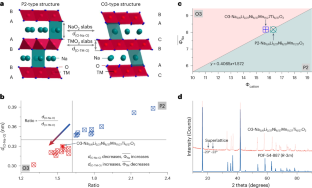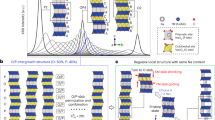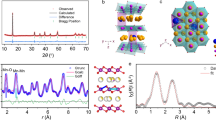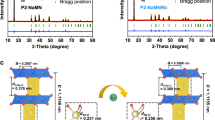Abstract
Sodium-ion batteries have not only garnered substantial attention for grid-scale energy storage owing to the higher abundance of sodium compared with lithium, but also present the possibility of fast charging because of the inherently higher sodium-ion mobility. However, it remains a phenomenal challenge to achieve a combination of these merits, given the complex structural chemistry of sodium-ion oxide materials. Here we show that O3-type sodium-ion layered cathodes (for example, Na5/6Li2/27Ni8/27Mn11/27Ti6/27O2) have the potential to attain high power density, high energy density (260 Wh kg−1 at the electrode level) and long cycle life (capacity retention of 80% over 700 cycles in full cells). The design involves introduction of characteristic P3-structural motifs into an O3-type framework that serves to promote sodium-ion diffusivity and address detrimental transition metal migration and phase transition at a high state of charge. This study provides a principle for the rational design of sodium-ion layered oxide electrodes and advances the understanding of the composition–structure–property relationships of oxide cathode materials.
This is a preview of subscription content, access via your institution
Access options
Access Nature and 54 other Nature Portfolio journals
Get Nature+, our best-value online-access subscription
$29.99 / 30 days
cancel any time
Subscribe to this journal
Receive 12 digital issues and online access to articles
$119.00 per year
only $9.92 per issue
Buy this article
- Purchase on Springer Link
- Instant access to full article PDF
Prices may be subject to local taxes which are calculated during checkout





Similar content being viewed by others
Data availability
The datasets generated and/or analysed during the study are available from the corresponding authors on reasonable request.
References
Dunn, B., Kamath, H. & Tarascon, J.-M. Electrical energy storage for the grid: a battery of choices. Science 334, 928–935 (2011).
Yabuuchi, N., Kubota, K., Dahbi, M. & Komaba, S. Research development on sodium-ion batteries. Chem. Rev. 114, 11636–11682 (2014).
Kubota, K., Kumakura, S., Yoda, Y., Kuroki, K. & Komaba, S. Electrochemistry and solid-state chemistry of NaMeO2 (Me = 3d transition metals). Adv. Energy Mater. 8, 1703415 (2018).
Mizushima, K., Jones, P. C., Wiseman, P. J. & Goodenough, J. B. LixCoO2 (0<x<-1): a new cathode material for batteries of high energy density. Mater. Res. Bull. 15, 783–789 (1980).
Fouassier, C., Delmas, C. & Hagenmuller, P. Evolution structurale et proprietes physiques des phases AxMO2 (A = Na, K; M = Cr, Mn, Co) (x≤1). Mater. Res. Bull. 10, 443–449 (1975).
Talaie, E., Duffort, V., Smith, H. L., Fultz, B. & Nazar, L. F. Structure of the high voltage phase of layered P2-Na2/3-z[Mn1/2Fe1/2]O2 and the positive effect of Ni substitution on its stability. Energy Environ. Sci. 8, 2512–2523 (2015).
Zhao, C. et al. Rational design of layered oxide materials for sodium-ion batteries. Science 370, 708–711 (2020).
Ong, S. P. et al. Voltage, stability and diffusion barrier differences between sodium-ion and lithium-ion intercalation materials. Energy Environ. Sci. 4, 3680–3688 (2011).
Okoshi, M., Yamada, Y., Yamada, A. & Nakai, H. Theoretical analysis on de-solvation of lithium, sodium, and magnesium cations to organic electrolyte solvents. J. Electrochem. Soc. 160, A2160–A2165 (2013).
Barthel, E. R., Martini, I. B. & Schwartz, B. J. How does the solvent control electron transfer? Experimental and theoretical studies of the simplest charge transfer reaction. J. Phys. Chem. B 105, 12230–12241 (2001).
Kuratani, K., Uemura, N., Senoh, H., Takeshita, H. T. & Kiyobayashi, T. Conductivity, viscosity and density of MClO4 (M = Li and Na) dissolved in propylene carbonate and γ-butyrolactone at high concentrations. J. Power Sources 223, 175–182 (2013).
Han, M. H., Gonzalo, E., Singh, G. & Rojo, T. A comprehensive review of sodium layered oxides: powerful cathodes for Na-ion batteries. Energy Environ. Sci. 8, 81–102 (2015).
Zhao, C. et al. Revealing high Na-content P2-type layered oxides as advanced sodium-ion cathodes. J. Am. Chem. Soc. 142, 5742–5750 (2020).
Zhao, C. et al. Ti substitution facilitating oxygen oxidation in Na2/3Mg1/3Ti1/6Mn1/2O2 cathode. Chem 5, 2913–2925 (2019).
Zhao, C., Ding, F., Lu, Y., Chen, L. & Hu, Y.-S. High-entropy layered oxide cathodes for sodium-ion batteries. Angew. Chem. Int. Ed. 59, 264–269 (2020).
Kubota, K. et al. Impact of Mg and Ti doping in O3 type NaNi1/2Mn1/2O2 on reversibility and phase transition during electrochemical Na intercalation. J. Mater. Chem. A 9, 12830–12844 (2021).
Han, M. H., Gonzalo, E., Casas-Cabanas, M. & Rojo, T. Structural evolution and electrochemistry of monoclinic NaNiO2 upon the first cycling process. J. Power Sources 258, 266–271 (2014).
Ding, F. et al. A novel Ni-rich O3-Na[Ni0.60Fe0.25Mn0.15]O2 cathode for Na-ion batteries. Energy Storage Mater. 30, 420–430 (2020).
Mortemard de Boisse, B., Carlier, D., Guignard, M., Bourgeois, L. & Delmas, C. P2-NaxMn1/2Fe1/2O2 phase used as positive electrode in Na batteries: structural changes induced by the electrochemical (de)intercalation process. Inorg. Chem. 53, 11197–11205 (2014).
Zhao, C., Avdeev, M., Chen, L. & Hu, Y.-S. An O3-type oxide with low sodium content as the phase-transition-free anode for sodium-ion batteries. Angew. Chem. Int. Ed. 57, 7056–7060 (2018).
Wang, Q. et al. Unlocking anionic redox activity in O3-type sodium 3d layered oxides via Li substitution. Nat. Mater. 20, 353–361 (2021).
Berthelot, R., Carlier, D. & Delmas, C. Electrochemical investigation of the P2–NaxCoO2 phase diagram. Nat. Mater. 10, 74–80 (2011).
Ding, F. et al. Using high-entropy configuration strategy to design Na-ion layered oxide cathodes with superior electrochemical performance and thermal stability. J. Am. Chem. Soc. 144, 8286–8295 (2022).
Wang, P.-F. et al. Ti-substituted NaNi0.5Mn0.5-xTixO2 cathodes with reversible O3−P3 phase transition for high-performance sodium-ion batteries. Adv. Mater. 29, 1700210 (2017).
Mu, L. et al. Prototype sodium-ion batteries using an air-stable and Co/Ni-free O3-layered metal oxide cathode. Adv. Mater. 27, 6928–6933 (2015).
Oh, S.-M. et al. High capacity O3-type Na[Li0.05(Ni0.25Fe0.25Mn0.5)0.95]O2 cathode for sodium ion batteries. Chem. Mater. 26, 6165–6171 (2014).
You, Y. et al. Insights into the improved high-voltage performance of Li-incorporated layered oxide cathodes for sodium-ion batteries. Chem 4, 2124–2139 (2018).
Yu, H., Guo, S., Zhu, Y., Ishida, M. & Zhou, H. Novel titanium-based O3-type NaTi0.5Ni0.5O2 as a cathode material for sodium ion batteries. Chem. Commun. 50, 457–459 (2014).
Delmas, C., Braconnier, J.-J., Fouassier, C. & Hagenmuller, P. Electrochemical intercalation of sodium in NaxCoO2 bronzes. Solid State Ion. 3–4, 165–169 (1981).
Xie, Y. et al. In operando XRD and TXM study on the metastable structure change of NaNi1/3Fe1/3Mn1/3O2 under electrochemical sodium-ion intercalation. Adv. Energy Mater. 6, 1601306 (2016).
Wang, Q. et al. Reaching the energy density limit of layered O3-NaNi0.5Mn0.5O2 electrodes via dual Cu and Ti substitution. Adv. Energy Mater. 9, 1901785 (2019).
Eum, D. et al. Voltage decay and redox asymmetry mitigation by reversible cation migration in lithium-rich layered oxide electrodes. Nat. Mater. 19, 419–427 (2020).
Dai, K. et al. High reversibility of lattice oxygen redox quantified by direct bulk probes of both anionic and cationic redox reactions. Joule 3, 518–541 (2019).
Voronina, N., Kim, H. J., Shin, M. & Myung, S.-T. Rational design of Co-free layered cathode material for sodium-ion batteries. J. Power Sources 514, 230581 (2021).
Wang, H. et al. Large-scale synthesis of NaNi1/3Fe1/3Mn1/3O2 as high performance cathode materials for sodium ion batteries. J. Electrochem. Soc. 163, A565–A570 (2016).
Zhou, Y.-N. et al. Phase transition behavior of NaCrO2 during sodium extraction studied by synchrotron-based X-ray diffraction and absorption spectroscopy. J. Mater. Chem. A 1, 11130–11134 (2013).
Lee, E. et al. New Insights into the performance degradation of Fe-based layered oxides in sodium-ion batteries: instability of Fe3+/Fe4+ redox in α-NaFeO2. Chem. Mater. 27, 6755–6764 (2015).
Susanto, D. et al. Anionic redox activity as a key factor in the performance degradation of NaFeO2 cathodes for sodium ion batteries. Chem. Mater. 31, 3644–3651 (2019).
Vassilaras, P. et al. Electrochemical properties and structural evolution of O3-type layered sodium mixed transition metal oxides with trivalent nickel. J. Mater. Chem. A 5, 4596–4606 (2017).
Maletti, S., Sarapulova, A., Schökel, A. & Mikhailova, D. Operando studies on the NaNi0.5Ti0.5O2 cathode for Na-ion batteries: elucidating titanium as a structure stabilizer. ACS Appl. Mater. Interfaces 11, 33923–33930 (2019).
Wang, P.-F. et al. An abnormal 3.7 volt O3-type sodium-ion battery cathode. Angew. Chem. Int. Ed. 57, 8178–8183 (2018).
Yabuuchi, N. et al. P2-type Nax[Fe1/2Mn1/2]O2 made from earth-abundant elements for rechargeable Na batteries. Nat. Mater. 11, 512–517 (2012).
Zhao, C., Lu, Y., Chen, L. & Hu, Y.-S. Ni-based cathode materials for Na-ion batteries. Nano Res. 12, 2018–2030 (2019).
Schulz, C. et al. Characterization of the soft X-ray spectrometer PEAXIS at BESSY II. J. Synchrotron Radiat. 27, 238–249 (2020).
Yoshida, H., Yabuuchi, N. & Komaba, S. NaFe0.5Co0.5O2 as high energy and power positive electrode for Na-ion batteries. Electrochem. Commun. 34, 60–63 (2013).
Yu, C.-Y. et al. NaCrO2 cathode for high-rate sodium-ion batteries. Energy Environ. Sci. 8, 2019–2026 (2015).
Yue, J.-L. et al. A quinary layer transition metal oxide of NaNi1/4Co1/4Fe1/4Mn1/8Ti1/8O2 as a high-rate-capability and long-cycle-life cathode material for rechargeable sodium ion batteries. Chem. Commun. 51, 15712–15715 (2015).
Yabuuchi, N., Yano, M., Yoshida, H., Kuze, S. & Komaba, S. Synthesis and electrode performance of O3-type NaFeO2-NaNi1/2Mn1/2O2 solid solution for rechargeable sodium batteries. J. Electrochem. Soc. 160, A3131–A3137 (2013).
Vassilaras, P. et al. Communication–O3-type layered oxide with a quaternary transition metal composition for Na-ion battery cathodes: NaTi0.25Fe0.25Co0.25Ni0.25O2. J. Electrochem. Soc. 164, A3484–A3486 (2017).
Hwang, J.-Y., Yu, T.-Y. & Sun, Y.-K. Simultaneous MgO coating and Mg doping of Na[Ni0.5Mn0.5]O2 cathode: facile and customizable approach to high-voltage sodium-ion batteries. J. Mater. Chem. A 6, 16854–16862 (2018).
Song, J. et al. Controlling surface phase transition and chemical reactivity of O3-layered metal oxide cathodes for high-performance Na-ion batteries. ACS Energy Lett. 5, 1718–1725 (2020).
Acknowledgements
We acknowledge the financial support from the Netherlands Organization for Scientific Research (NWO) grant 16122 (M.W.). This research used 11-ID-C beamline at the Advanced Photon Source, a US Department of Energy (DOE) Office of Science User Facility operated for the DOE Office of Science by Argonne National Laboratory under Contract grant DE-AC02-06CH11357 (J.L.). We also acknowledge the financial support from the National Natural Science Foundation of China grant 51991344 (X.B.) and the Chinese Academy of Sciences grant XDB33000000 (X.B.).
Author information
Authors and Affiliations
Contributions
M.W. and Q.W. conceived the project. Q.W., D.Z., Z.Y. and C.Z. carried out the synthesis, material characterization and electrochemical measurements. H.G. collected the NPD data; L.W. and J.L. collected the SXRD data; and Q.W. and C.Z. interpreted the data. J.W. and X.B. performed the TEM measurement. D.Z., D.W. and G.S. collected and interpreted the XAS and RIXS data. All authors participated in discussing the results. Q.W., M.W., C.Z., J.L. and D.Z. prepared and revised the paper with inputs from all other authors.
Corresponding authors
Ethics declarations
Competing interests
The authors declare no competing interests.
Peer review
Peer review information
Nature Sustainability thanks Huiwen Ji, Yong-Mook Kang and the other, anonymous, reviewer(s) for their contribution to the peer review of this work.
Additional information
Publisher’s note Springer Nature remains neutral with regard to jurisdictional claims in published maps and institutional affiliations.
Supplementary information
Supplementary Information
Supplementary Notes 1–3, Figs. 1–22 and Tables 1–11.
Rights and permissions
Springer Nature or its licensor (e.g. a society or other partner) holds exclusive rights to this article under a publishing agreement with the author(s) or other rightsholder(s); author self-archiving of the accepted manuscript version of this article is solely governed by the terms of such publishing agreement and applicable law.
About this article
Cite this article
Wang, Q., Zhou, D., Zhao, C. et al. Fast-charge high-voltage layered cathodes for sodium-ion batteries. Nat Sustain 7, 338–347 (2024). https://doi.org/10.1038/s41893-024-01266-1
Received:
Accepted:
Published:
Issue Date:
DOI: https://doi.org/10.1038/s41893-024-01266-1
This article is cited by
-
Freedom of chemical space
Nature Sustainability (2024)



